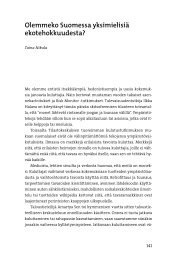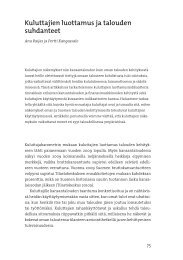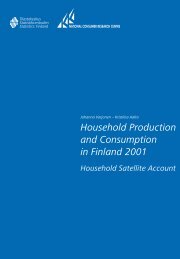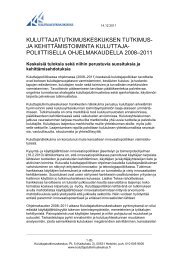Household Production and Consumption in Finland 2001
Household Production and Consumption in Finland 2001
Household Production and Consumption in Finland 2001
You also want an ePaper? Increase the reach of your titles
YUMPU automatically turns print PDFs into web optimized ePapers that Google loves.
6.3 Conclusions by type ofhousehold<br />
There are marked differences between different household types both with<br />
respect to the volume of production, its breakdown between different<br />
pr<strong>in</strong>cipal functions <strong>and</strong> the structure of production. <strong>Production</strong> volumes<br />
<strong>in</strong>crease more or less steadily from the first to the fifth <strong>in</strong>come qu<strong>in</strong>tile. The<br />
m<strong>in</strong>or deviations seen <strong>in</strong> this pattern are expla<strong>in</strong>ed by the types of household,<br />
suggest<strong>in</strong>g that household structure <strong>and</strong> life-stage have a greater impact on<br />
household production than <strong>in</strong>comes.<br />
The use of <strong>in</strong>termediate goods <strong>and</strong> services decreases <strong>and</strong> the share of<br />
labour <strong>in</strong>creases with advanc<strong>in</strong>g age both among people liv<strong>in</strong>g alone <strong>and</strong><br />
among couples. Given the high proportion of care provision, the value of<br />
labour <strong>in</strong> families with small children exceeds the figures for other types of<br />
households.<br />
The purchases of f<strong>in</strong>al consumption products are highest <strong>in</strong> relative terms<br />
<strong>in</strong> the provision of meals <strong>and</strong> snacks, second highest <strong>in</strong> cloth<strong>in</strong>g <strong>and</strong> third<br />
highest <strong>in</strong> hous<strong>in</strong>g. The one exception here is represented by families with<br />
small children, where the expenditure on childcare services is somewhat<br />
higher than expenditure on clothes <strong>and</strong> cloth<strong>in</strong>g care. S<strong>in</strong>ce day care is heavily<br />
subsidised by the public sector, the results for the proportion of f<strong>in</strong>al<br />
consumption purchases <strong>in</strong> this comparison are lower than the true figures. In<br />
the provision of meals, the mass production of foods is highly efficient <strong>and</strong><br />
highly processed products provide a competitive option to household<br />
production, <strong>in</strong> both price <strong>and</strong> quality terms. The shift to market production<br />
has been even more pronounced <strong>in</strong> the manufacture of clothes. People no<br />
longer have the same skills they used to, which is another reason why DIY<br />
clothes no longer are a competitive option. Do<strong>in</strong>g the laundry at home with an<br />
automatic wash<strong>in</strong>g mach<strong>in</strong>e, on the other h<strong>and</strong>, is cheaper <strong>and</strong> more<br />
convenient than us<strong>in</strong>g professional laundry services. Very few households<br />
reported us<strong>in</strong>g these services. The clean<strong>in</strong>g services market was also very much<br />
<strong>in</strong> its <strong>in</strong>fancy <strong>in</strong> F<strong>in</strong>l<strong>and</strong> <strong>in</strong> <strong>2001</strong> (Aalto 2003).<br />
It seems then that age has an impact on the volume of household<br />
production <strong>and</strong> particularly on the share of labour <strong>in</strong> household production.<br />
However it is too early to say whether the reason for this lies <strong>in</strong> generational<br />
differences <strong>in</strong> lifestyles, or whether the difference is due to life-stage or<br />
household structure. Our focus here is primarily on life-stage <strong>and</strong> structural<br />
factors because no time series are as yet available that would describe<br />
generational differences. S<strong>in</strong>gle-person households <strong>and</strong> couples aged over 65<br />
spend more time <strong>in</strong> unpaid work than younger households, <strong>and</strong> <strong>in</strong> these<br />
households, labour accounts for a larger proportion of the value of production.<br />
The older people are used to self-provision<strong>in</strong>g. They also have more time on<br />
their h<strong>and</strong>s <strong>and</strong> consequently they might work more slowly. What is more, not<br />
all pensioners can take advantage of subsidised meals at service centres <strong>in</strong> the<br />
same way as people who go to work, so they often prepare their own meals.<br />
60 Statistics F<strong>in</strong>l<strong>and</strong> National Consumer Research Centre
















